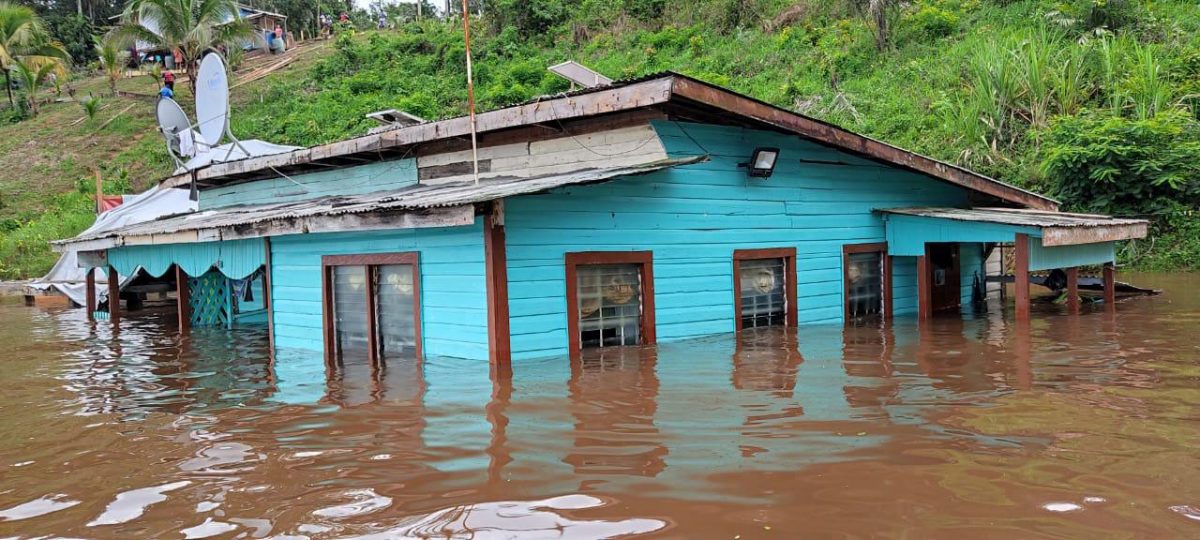The Civil Defence Commission (CDC) yesterday said that just over 36,000 households from 300 communities countrywide have been affected by flooding.
This disclosure was made by the CDC’s Senior Response Officer, Captain Salim October during a virtual stakeholder meeting held to fully activate the National Emergency Operations Centre (NEOC). According to October, since May 18th, the CDC has received reports that 36,083 households in total have been affected by the flooding countrywide.
In Region Six, 12, 391 households are affected while 7,166 have been affected in Region Three; 6,040 in Region Nine; 2,825 in Region One; 2,535 in Region Four; 1,084 in Region Two; 1,791 in Region Ten; 920 in Region Five; 819 in Region Seven and 512 in Region Eight.
In addition, he said that 216 persons are currently being housed at nine temporary shelters that have been activated in regions Two, Five, Nine and Ten. Of that number 175 of those persons are from Region Ten, 30 from Region Two, seven from Region Five and four from Region Nine.
Weeks of torrential downpours have caused rivers and creeks to overflow in the hinterland regions leaving homes, farms, shops and mining pits inundated
In Region Seven, the flooding especially in the Middle and Upper Mazaruni riverine communities remains the same. Having gone on a recent visit to these areas, Region Seven Vice Chairwoman Kamal Persaud related that the impact of the flooding is extremely devastating.
“Water has covered farmland, buildings and (entire) mining landings and so forth. The devastation is unthinkable. Houses are covered to the top. Families had to relocate and are living in makeshift camps, losing everything that they own in their homes,” she described.
According to Persaud, the rivers have flowed 400 feet inland and to heights of around 14 feet. She related that residents have explained that they have never experienced this level of flooding and never thought that the rivers would flow so far inland. She stated that everyone is expecting that the water levels will continue to increase. She noted that hundreds of persons will need assistance once the flooding is over as many are counting millions in losses.
For many, she said, the flooding was unexpected as water quietly seeped into their homes during the wee hours of the morning. “They did not expect it to reach to those levels and the water rose so fast so as some residents explained at 3 am, they woke up and found water waist high in their homes,” she said.
Region Two
In Region Two, according to Chairwoman Vilma DaSilva, water has receded in most of the affected areas such as Karawab, St Monica and Kabakaburi in the Upper Pomeroon. This has resulted in many of those who are being housed in temporary shelters wanting to go back to their homes.
“They were advised to stay in the shelter because we are projecting that we will have more rain until August,” she noted, before adding that the Regional Democratic Council (RDC) will be assisting those victims with food and water and healthcare services will be provided.
Residents of Upper Pomeroon communities told Stabroek News on Monday that they were in dire need of potable water. Da Silva said that just yesterday, after receiving complaints that residents in the three affected communities were in need of potable water, supplies were dispatched. She said that even before those complaints, they had placed a tankful of water at the school and residents could’ve gone to get water. She noted that the tank has to be refilled every two days and the council is ensuring that this is done.
Da Silva stated there has been no major flooding on the Essequibo Coast.
Region Nine
Meanwhile, according to Region Nine Chairman Bryan Allicock, most of the floodwater in Lethem has receded but due to the rising Takutu and Ireng rivers, water levels started to rise again late yesterday afternoon. “We are prepared for the eventuality [flooding],” he stated.
In Region Five, water levels remain the same, according to regional chairman Vickchand Ramphal. However, he said a team is on the ground conducting assessments and providing assistance where possible. He noted that one of the most urgent needs of flood victims is potable water and this has been delivered to many persons who are affected.
He disclosed that Moraikobai up the Mahaicony Creek is one of the most impacted areas with some 180 houses affected. However, he said, according to its Toshao, water is slowly receding.
According to the CDC, regions Ten, Seven, Six and Five are the most impacted. Addi-tionally, it was disclosed that 21,284 cleaning hampers and 26,045 food hampers have been distributed to the various regions since May 18th to present to affected families.
The CDC says it will continue to dispatch emergency relief supplies to flood-affected communities, manage and support shelter operations in Regions where these are activated and engage with regional and international stakeholders for support to the national flood response.
With the rainy weather likely to persist, the National Weather Watch Centre has advised that all Guyanese should take the necessary precautions to safeguard against possible flooding, wind, lightning, and mudslides.
Guyana’s flooding has been classified as a Level 2 Disaster under the Caribbean Disaster Emergency Management Agency’s (CDEMA) regional response mechanism, but the CDC has said that five regions are classified even worse as the impact is varied.
Prime Minister Mark Phillips last Thursday reported to the National Assembly that the rainfall recorded over the past month was the second highest in four decades.
“Based on the latest seasonal reports, it is estimated that we will continue to experience above normal rainfall during the period June to August, 2021,” Phillips also said.






